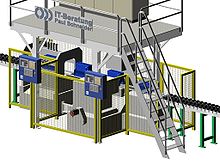Uses
The software aims to extend the field of application of Autodesk Inc.'s CAD software Autodesk Inventor, which is usually used for mechanical construction in mechanical engineering and plant engineering. ASi-Profile enables the user to create supporting structures, substructures, control- and maintenance platforms, stairways, barriers, etc. which are typical elements in the constructional steelwork area. [1]

Mechanical engineering is the discipline that applies engineering, physics, engineering mathematics, and materials science principles to design, analyze, manufacture, and maintain mechanical systems. It is one of the oldest and broadest of the engineering disciplines.
Use in mechanical engineering, plant engineering
Conventional 3D CAD systems for mechanical engineering usually lack of functions to create steel constructions. As an add-on application, the software tries to fill the gap between mechanical engineering and constructional steelworking, enabling the designer, for example, to create a supporting frame for a machine or the required maintenance platform in the same software.
The scope in locksmithing and metal fabrication is often to plan and design stairways, platforms, balconies or railings, etc., with the intention of creating a customized, individual structure, setting a special focus on its design. ASi-Profile is used to simplify the construction process and to create realistic views of the structures.
Design can have different connotations in different fields of application, but there are two basic meanings of design: as a verb and as a noun.

AutoCAD is a commercial computer-aided design (CAD) and drafting software application. Developed and marketed by Autodesk, AutoCAD was first released in December 1982 as a desktop app running on microcomputers with internal graphics controllers. Before AutoCAD was introduced, most commercial CAD programs ran on mainframe computers or minicomputers, with each CAD operator (user) working at a separate graphics terminal. Since 2010, AutoCAD was released as a mobile- and web app as well, marketed as AutoCAD 360.

Computer-aided design (CAD) is the use of computers to aid in the creation, modification, analysis, or optimization of a design. CAD software is used to increase the productivity of the designer, improve the quality of design, improve communications through documentation, and to create a database for manufacturing. CAD output is often in the form of electronic files for print, machining, or other manufacturing operations. The term CADD is also used.
AutoLISP is a dialect of the programming language Lisp built specifically for use with the full version of AutoCAD and its derivatives, which include AutoCAD Map 3D, AutoCAD Architecture and AutoCAD Mechanical. Neither the application programming interface (API) nor the interpreter to execute AutoLISP code are included in the AutoCAD LT product line.

Computervision, Inc. (CV) was an early pioneer in Computer Aided Design and Manufacturing (CAD/CAM). Computervision was founded in 1969 by Marty Allen and Philippe Villers, and headquartered in Bedford, Massachusetts, United States. Its early products were built on a Data General Nova platform. Starting around 1975, Computervision built its own "CGP" Nova-compatible 16-bit computers with added instructions optimized for graphics applications and using its own operating system known as Computervision Graphic Operating System (CGOS). In the 1980s, Computervision rewrote their code to operate on Unix-based platforms.
DGN (design) is the name used for CAD file formats supported by Bentley Systems, MicroStation and Intergraph's Interactive Graphics Design System (IGDS) CAD programs. The DGN format is used in construction projects, including buildings, highways, bridges, process plants, shipbuilding. DGN is a competing format to Autodesk's DWG.

STL is a file format native to the stereolithography CAD software created by 3D Systems. STL has several after-the-fact backronyms such as "Standard Triangle Language" and "Standard Tessellation Language". This file format is supported by many other software packages; it is widely used for rapid prototyping, 3D printing and computer-aided manufacturing. STL files describe only the surface geometry of a three-dimensional object without any representation of color, texture or other common CAD model attributes. The STL format specifies both ASCII and binary representations. Binary files are more common, since they are more compact.

Rhinoceros is a commercial 3D computer graphics and computer-aided design (CAD) application software developed by Robert McNeel & Associates, an American, privately held, employee-owned company founded in 1980. Rhinoceros geometry is based on the NURBS mathematical model, which focuses on producing mathematically precise representation of curves and freeform surfaces in computer graphics.

Autodesk Vault is a data management tool integrated with Autodesk Inventor Series, Autodesk Inventor Professional, AutoCAD Mechanical, AutoCAD Electrical, Autodesk Revit and Civil 3D products. It helps design teams track work in progress and maintain version control in multi-user environments. It allows them to organize and reuse designs by consolidating product information and reducing the need to re-create designs from scratch. Users can store and search both CAD data and non-CAD documents.
Design Web Format (DWF) is a secure file format developed by Autodesk for the efficient distribution and communication of rich design data to anyone who needs to view, review, or print design files. Because DWF files are highly compressed, they are smaller and faster to transmit than design files, without the overhead associated with complex CAD drawings. With DWF functionality, publishers of design data can limit the specific design data and plot styles to only what they want recipients to see and can publish multisheet drawing sets from multiple AutoCAD drawings in a single DWF file. They can also publish 3D models from most Autodesk design applications.

Autodesk Revit is building information modelling software for architects, landscape architects, structural engineers, MEP engineers, designers and contractors. The original software was developed by Charles River Software, founded in 1997, renamed Revit Technology Corporation in 2000, and acquired by Autodesk in 2002. The software allows users to design a building and structure and its components in 3D, annotate the model with 2D drafting elements, and access building information from the building model's database. Revit is 4D BIM capable with tools to plan and track various stages in the building's lifecycle, from concept to construction and later maintenance and/or demolition.
Navisworks is a 3D design review package for Microsoft Windows.
The Open Design Alliance is a nonprofit organization of over 1,250 members in 50 countries which develops Teigha, a software development platform used to create engineering applications including CAD. The main idea is to make core graphics technology accessible to software developers allowing them to focus on application development.

NEi Nastran was an engineering analysis and simulation software product of NEi Software Based on NASA's Structural Analysis program NASTRAN, the software is a finite element analysis (FEA) solver used to generate solutions for linear and nonlinear stress, dynamics, and heat transfer characteristics of structures and mechanical components. NEi Nastran software is used with all major industry pre and post processors including Femap, a product of Siemens PLM Software, in house brands NEi Nastran in-CAD, NEi Fusion, and NEi Works for SolidWorks.
This software was acquired by Autodesk in May 2014.
BricsCAD is a software application for computer-aided design (CAD), developed by Bricsys nv. The company was founded in 2002 by Erik de Keyser, a longtime CAD entrepreneur. In 2011 Bricsys acquired the intellectual property rights from Ledas for constraints-based parametric design tools, permitting the development of applications in the areas of direct modeling and assembly design. Bricsys is headquartered in Ghent, Belgium, has additional development centers in Nizhny Novgorod and Novosibirsk, Russia; Bucharest, Romania and Singapore. Bricsys is a founding member of the Open Design Alliance, and joined the BuildingSMART International consortium in December of 2016.
GRAITEC is an Autodesk Reseller and developer of CAD / CAE software for the civil engineering and construction industries.
Advance Concrete is a computer-aided design (CAD) software application was developed by GRAITEC, but is now an Autodesk product, used for modeling and detailing reinforced concrete structures. Advance Concrete is used in the structural / civil engineering and drafting fields.
Advance Steel is a CAD software application for 3D modeling and detailing of steel structures and automatic creation of fabrication drawings, bill of materials and NC files, was developed by GRAITEC, but is now an Autodesk product. The software run on AutoCAD.








